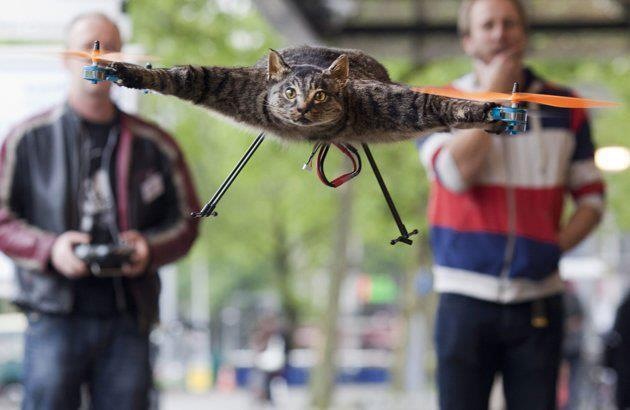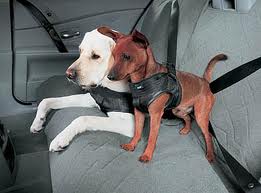
 Have a Happy and Safe Fourth!!
Have a Happy and Safe Fourth!!
We welcome our 102nd AM/FM affiliate, WLBK-FM 98.9 in DeKalb, Illinois!!
Get Animal Radio® Headlines emailed to you, or catch us on ![]() Twitter and
Twitter and ![]() Facebook.
Facebook.
"Like" Animal Radio® on Facebook - and win goodies for you and your pet.
Animal Radio® Show #657
 Nancy Cartwright Guests
Nancy Cartwright Guests
Probably the most recognized voice in the world, the extremely talented Nancy Cartwright aka Bart Simpson (The Simpsons) shares stories about her dogs, cats, sea-horses, and even her prized fiberglass cow named "Milkdud."
Bowser Beer
A Seattle-based company has come up with a new way for man's best friend to kick back and stay cool during the dog days of summer. Founder Jenny Brown says she's created a non-alcoholic drink for dogs she's dubbed Bowser Beer. Brown says she spent more than a year developing the flat broth mixture with barley, vitamins and glucosamine for healthy joints.
 One Dog At A Time
One Dog At A Time
Pen Farthing and his troop of young Royal Marines survived frequent engagements with the Taliban. Appalled by the horrors of local dog fighting in Afghanistan, Pen had no choice but to intervene. Now he devotes his life to rescuing dogs from the war-torn region.
 Willie Nelson Supports Ban On Slaughtering Horses
Willie Nelson Supports Ban On Slaughtering Horses
Willie Nelson continues to support the ban on the slaughtering of wild horses. The country legend states that there's no reason for the slaughter. He adds that protecting the animals could actually provide jobs.
Listen to this Animal Radio® episode
Animal Radio® Show #656
 Emmylou Harris Guests
Emmylou Harris Guests
The very multi-talented musician and animal advocate Emmylou Harris is our special guest for this week's Season of the Stars. Emmylou runs an animal rescue on her property in Nashville.
Do You Use Your Dog As Date Bait?
Would you use your Dalmatian to get a date with a like-minded person? Do people use their dogs as date bait? A recent survey about what breeds are attractive to the opposite sex revealed that if attracting a date is your goal, you can't go wrong with retrievers, popular breeds for both sexes. According to the survey, the top dog breed to attract men is Golden Retrievers, followed by Labrador Retrievers, Chihuahuas, Poodles and Beagles.
PETA's Unorthodox Strategy
 PETA is known for using controversial methods to bring attention to animal issues. With the launch of PETA.xxx, a sexy website featuring Ron Jeremy, Jenna Jameson, Rose McGowan and the controversial Sasha Grey, the animal rights organization is attempting to raise awareness for animals.
PETA is known for using controversial methods to bring attention to animal issues. With the launch of PETA.xxx, a sexy website featuring Ron Jeremy, Jenna Jameson, Rose McGowan and the controversial Sasha Grey, the animal rights organization is attempting to raise awareness for animals.
Puppies Instead of Panhandling
 San Francisco's plans on using dogs to reduce its panhandling problem. The city will initiate a new program, believed to be the first of its kind in the country, encouraging homeless individuals to give up panhandling. In exchange, they'll receive a small stipend to foster problematic puppies until they're ready for adoption. Participants must promise to stop panhandling, and if they are caught begging with the puppy, the animal will be taken back to the shelter. In exchange, the approved applicant will receive $50-$75 a week, as well as several training sessions, regular check-ins, and all the dog food, toys, leashes and veterinary care they need. Participants will ideally be trained in grooming, dog walking or other animal-related skills so that they can join the regular workforce.
San Francisco's plans on using dogs to reduce its panhandling problem. The city will initiate a new program, believed to be the first of its kind in the country, encouraging homeless individuals to give up panhandling. In exchange, they'll receive a small stipend to foster problematic puppies until they're ready for adoption. Participants must promise to stop panhandling, and if they are caught begging with the puppy, the animal will be taken back to the shelter. In exchange, the approved applicant will receive $50-$75 a week, as well as several training sessions, regular check-ins, and all the dog food, toys, leashes and veterinary care they need. Participants will ideally be trained in grooming, dog walking or other animal-related skills so that they can join the regular workforce.
Listen to this Animal Radio® episode
Animal Radio® Show #655
 Heart-throb Josh Duhamel Guests
Heart-throb Josh Duhamel Guests
Actor and hubby of Fergie (Black Eyed Peas), Josh Duhamel has a thing for dogs! He's teamed up with PetSmart Charities to promote their 5 millionth adoption. He changed his way of thinking when he met "Meatloaf," a dog that was named that because it resembled one.
Half Cat €“ Half Machine!
 A Dutch artist is honoring his departed feline friend by creating a "half cat, half machine." Bart Jansen turned the taxidermied remains of his pet Orville into a working radio-controlled helicopter. Jansen explains that Orville was named after iconic aviator Orville Wright, so taking him airborne seemed like a fitting tribute. Jansen says Orville will be "flying with the birds" once he gets larger propellers and more powerful engines on his birthday.
A Dutch artist is honoring his departed feline friend by creating a "half cat, half machine." Bart Jansen turned the taxidermied remains of his pet Orville into a working radio-controlled helicopter. Jansen explains that Orville was named after iconic aviator Orville Wright, so taking him airborne seemed like a fitting tribute. Jansen says Orville will be "flying with the birds" once he gets larger propellers and more powerful engines on his birthday.
First Recalls, Then Lawsuits
 Following an ever-increasing list of Salmonella-related recalls, Diamond Pet Foods faces what may be the first lawsuit filed in connection with the illness. Pritzker Olsen, a national law firm specializing in food safety, filed the suit last week against Diamond Pet Food Processors and Costco Wholesale Corp. in U.S. District Court in New Jersey. According to the firm's website, the suit was filed on behalf of the father of an infant who was sickened by a rare strain of salmonella infants and hospitalized for three days.
Following an ever-increasing list of Salmonella-related recalls, Diamond Pet Foods faces what may be the first lawsuit filed in connection with the illness. Pritzker Olsen, a national law firm specializing in food safety, filed the suit last week against Diamond Pet Food Processors and Costco Wholesale Corp. in U.S. District Court in New Jersey. According to the firm's website, the suit was filed on behalf of the father of an infant who was sickened by a rare strain of salmonella infants and hospitalized for three days.
"Click It Or Ticket" Applies To Pets Too
 New Jersey is cracking down on pets in transit - and says "click it or ticket" now applies to cats and dogs, too. The SPCA and Motor Vehicle Commision teamed up at a public education event in the Garden State to talk about the dangers of transporting animals without proper restraint. New Jersey is the only state where driving with pets loose in the car is a violation of animal cruelty law. Drivers cited for failing to properly secure their pet, can face a ticket of between $250 and $1,000 and as much as six months in jail.
New Jersey is cracking down on pets in transit - and says "click it or ticket" now applies to cats and dogs, too. The SPCA and Motor Vehicle Commision teamed up at a public education event in the Garden State to talk about the dangers of transporting animals without proper restraint. New Jersey is the only state where driving with pets loose in the car is a violation of animal cruelty law. Drivers cited for failing to properly secure their pet, can face a ticket of between $250 and $1,000 and as much as six months in jail.
Listen to this Animal Radio® episode

Animal Radio® Show #654
 Damages' Glenn Close Guests
Damages' Glenn Close Guests
Despite her anti-animal roles she plays, Glenn Close is very much an animal lover. In fact, she even blogs about dogs and the relationships with their people. The Oscar winning actress spills all as she joins the Animal Radio® gang for the Season of Stars.
Nearly Half Of All Pet Owners Will Travel This Summer
PetRelocation.com, an international pet travel and pet transportation service provider, has announced the results of its third annual Summer Pet Travel Survey. For 2012, travel trends have fluctuated, but overall the popularity of pet travel is holding steady and consumer demands are more specific than ever. Nearly half of pet owners will travel this summer. 47% of respondents said they planned to travel with their pets within the next three months, and another 40% plan to travel within the next year.
Now's The Time To Start Worrying About Ticks
 Washington's Health Department says it's time to worry about ticks now that summer is here. Veterinarian Dr. Ruth McPete says few people realize that modern rural housing developments are often making America's tick problem worse. She says those fragments are fertile breeding grounds for ticks. Ticks can carry health problems such as Lyme disease.
Washington's Health Department says it's time to worry about ticks now that summer is here. Veterinarian Dr. Ruth McPete says few people realize that modern rural housing developments are often making America's tick problem worse. She says those fragments are fertile breeding grounds for ticks. Ticks can carry health problems such as Lyme disease.
Cat Scratch Fever
 We'll share practical way to avoid inappropriate scratching and how to deal with cat bites, which can turn serious and ugly very fast. Why do local authorities need to quarantine domestic cats that bite? Dr. Debbie has answers.
We'll share practical way to avoid inappropriate scratching and how to deal with cat bites, which can turn serious and ugly very fast. Why do local authorities need to quarantine domestic cats that bite? Dr. Debbie has answers.
Listen to this Animal Radio® episode
Animal Radio® Show #653
 The Office's Jenna Fischer Visits
The Office's Jenna Fischer Visits
Don't miss this "must hear" interview with Jenna Fischer (Pam from NBC's The Office)! She shares her most intimate secrets about her cat and how she spoils the furball. She says "I'm guilty of allowing my cat on the dinner table. When guests are over and he hops on the table, I pretend like that's the first time it's ever happened."
![]() Dogs In The City
Dogs In The City
Justin Silver from the new hit TV reality series "Dogs in the City" (CBS) says that most dog behavior problems actually stem from the owner. His new show is all about developing the relationship between dog and human.
 Lucky's In A Rush To Get Married
Lucky's In A Rush To Get Married
If you missed Lucky the dog's posh wedding shower, you can still make it to her July 12 wedding at New York's exclusive Essex House Hotel. Lucky, who holds the world record as the animal most photographed with celebrities, has a new mission: searching for a husband. The marital-minded Maltese is taking applications for the right "Guy," which owner and animal advocate Wendy Diamond says need not necessarily be a canine.
Would You Take Your Dog To Church With You?
 A Florida pastor says he decided not to turn away any four-legged parishioners who wanted to join their two-legged companions at church this past weekend. Pastor David Hughes says almost 500 dogs filled the pews for the first of two Dog Day Weekend services at the Church of the Glades in Coral Springs.
A Florida pastor says he decided not to turn away any four-legged parishioners who wanted to join their two-legged companions at church this past weekend. Pastor David Hughes says almost 500 dogs filled the pews for the first of two Dog Day Weekend services at the Church of the Glades in Coral Springs.
10 Best Cities To Be A Pet
Headline News and World Report announced the 10 Best Cities to be a Pet. Arizona took the cake with a 40% showing. Four out of 10 cities were in Arizona. The poll was based on a spending analysis that was conducted. The study encompassed a recent analysis of transactions by Bundle, a spending analysis firm. The study proved that the city with the highest average dollars spent on pets was Scottsdale, Arizona.
Listen to this Animal Radio® episode

Animal Radio® FREE Pets & People Drug Discount Card
SAVE NOW ON ALL UNINSURED MEDS!! For both you and your pet!
![]() You may already know how expensive pet medication can be. Especially when pet insurance doesn't cover drugs.
You may already know how expensive pet medication can be. Especially when pet insurance doesn't cover drugs.
All of us at Animal Radio® are doing our best to help out. After all, we're all in the same financial boat and don't want the pets to suffer because a medicine's cost is prohibitive. We made a deal with the top pharmacy benefits managers. Here's what we came up with:
- The Animal Radio® Pets & People Drug Discount Card is FREE.
- It offers 15-55% discount on pet medicines or uninsured human medicines.
- It's usable at almost 60,000 pharmacies, including Walgreens, Wal-mart, Rite-Aid, Target, Costco, CVS...all the biggies!
- Card is pre-activated and never expires.
- Great for small businesses that can't afford benefits for employees, or even your church or local Senior Center. We will gladly send you as many cards as you need.
- You can print out the FREE card online at: http://animalradio.com/Pets_People_Discount_Drug_Card.html
Or, if you would like us to mail you a free card, send a self-addressed stamped envelope to:
Animal Radio Drug Card
699 Paula Street
Morro Bay, CA. 93442
Please help spread the word. Your friends will thank you.
Print Your Free Drug Discount Card
Animal Radio® Headlines
Lost-pet poster: Six tips for a more effective sign
I returned home Saturday to two discoveries: Both of my dogs were gone from the yard. And worse: One dog's collar had slipped off and was lying by the fence.
Wally returned home on his own, but with Daisy still missing -- and lacking any identification -- I had only two likely ways of seeing her again. Someone would have to catch her, drive her to an animal shelter and have her scanned for a microchip containing my contact information. Or someone would have to see her on a lost-dog poster.
It's good I didn't know the odds. According to the National Council on Pet Population Study and Policy, a nonprofit organization whose members include the Humane Society of the United States, the American Society for the Prevention of Cruelty to Animals and the American Veterinary Medical Assn., less than 2% of lost cats and less than 20% of lost dogs are returned to their owners €” and that's if the animal has a tag, a microchip or both.
I poured my energy into the posters, but making an effective lost-pet flier proved to be art unto itself, a fact that I learned the hard way. Only after I had posted dozens of fliers around my neighborhood did I realize all of the mistakes I had made in the one pictured above. Here are six things I would have done differently:
1. Photo selection. I thought I was smart by making a photo of Daisy so prominent -- taking up half of the 8.5-by-11-inch paper. But as I taped up the flier alongside other lost-dog posters on a lamppost, I realized someone else's sign was more effective: It also used a large photo, but one that showed only the dog's distinctive face -- not the whole body. As I drove from intersection to intersection, Daisy's photo was hard to make out, but that close-up shot of another's dog face grabbed my attention and prompted passersby to stop and read the signs. Even though my signs were color, the black-and-white fliers with the face in detail were better: graphic, easy to see from afar and emotionally compelling. If Daisy had distinctive body markings or a memorable shape, the full-body photo would have been wise. But she didn't. I should have emphasized her face in the photo, then let words convey her size.
2. Text selection. The words on my posters were brief, as they should have been. But I made two key errors: I used a serif font (Times Roman), when a sans-serif font (such as Arial or Helvetica) would have allowed for bolder letters that were easier to read from a passing car. I also made the largest words on my flier "LOST DOG." Everyone could tell that these fliers were for a lost pet, even if the text had been in a foreign language. A more effective strategy would have been to put key visual descriptions in the biggest type: "BLACK LAB," or "TERRIER PUPPY" or "3-LEGGED CAT" or whatever the case may be. These key words might resonate immediately with passersby and stick in their heads as they travel through the neighborhood.
3. Sign locations. As I madly taped fliers to streetlights and utility poles, I worried that they would be pulled off within a day or two -- perhaps by city workers just doing their job. Had I to do it over again, I would have made some larger signs -- poster board, not paper -- and asked homeowners on key streets if they would have allowed me to stake those signs in their yards, perhaps near a sidewalk or intersection. Others who had lost pets later recommended using fluorescent poster board, either as the sign itself or simply as an eye-grabbing backdrop. Just glue an 8.5-by-11 flier to a larger piece of colorful poster board.
4. Number of copies. I underestimated the number of fliers to make at the copy center. How? I guessed how many I might put on street lights, but I didn't consider how many I might hand out to people. As I searched for Daisy by foot, I encountered neighbors and dog walkers who were sympathetic and vowed to keep an eye out. I gave a flier to them all, and they essentially expanded my search team. I initially printed 75 copies, but I probably should have made 150, maybe 200.
5. Preparedness. As soon as I found that collar in the yard, time felt unbelievably crucial. With every passing minute, I imagined Daisy wandering farther from home -- and farther from where I would be posting fliers. Superstitious pet owners may think I'm crazy, but I'm convinced I now should approach a missing dog like an earthquake: Get the kit ready in advance. Create a flier now, include the best photo and update it every year. Put the design in multiple places, including a flash drive stored with a big roll of sturdy tape and a staple gun. I wasted two hours calling my partner (who had the laptop where all of our photos are stored) in vain, then madly searching for a decent print of Daisy, then writing a flier, then running to the copy center and then buying tape at CVS because the copy center was sold out. Those were two agonizing hours that I just wanted to be searching for my dog.
6. Hope. Don't lose it. Because I was looking for a dog that had no identification, no penchant to come when called by name and no spectacular sense of direction or intelligence (love her, but let's be honest), I was fairly certain that I would never see Daisy again. As night fell of the day of her disappearance, a dog walker in the neighborhood told me to keep my chin up. She lost her springer spaniel, and two months later it was found at a park miles away, she said. Indeed, SPCALA has an "Animal Finder" advice sheet that said: "A lost pet can wander the streets for weeks or months and people who find lost pets may keep them for several weeks before taking them to a shelter." My local city and Humane Society shelters said the same thing, encouraging me to check their websites daily and to walk their kennels regularly, just in case.
I didn't need to, I'm happy to report. A dog lover corralled Daisy and drove her to a city shelter, which scanned her microchip and called at night to say my girl was waiting to be bailed out. I don't know anything about the good Samaritan other than she told a shelter employee that Daisy "seemed like a nice dog." Daisy has been reunited with Wally, and my fence has been mended. And now I've got a lost dog flier on a flash drive ready to go, garden stakes in the garage and a roll of tape stashed in the den, just in case.
The NEW Animal Radio® APP is available for ![]() Android and
Android and ![]() iPhone! Get it NOW!
iPhone! Get it NOW!
States unleash laws on restraining pets while driving
Not all driving distractions ring or beep. Some of them bark.
And so, animal protection and automobile safety officials nationwide are starting to unleash a new message: Restrain your pet on the road.
"You wouldn't put your child in the car unrestrained, so you shouldn't put your pet in the car unrestrained, either," says Col. Frank Rizzo, superintendent of the New Jersey Society for the Prevention of Cruelty to Animals (NJSPCA).
In a 2010 survey by AAA, 20% of participants admitted to letting their dog sit on their lap while driving. A "staggering" 31% said they were distracted by their dog while driving, says Raymond Martinez, chairman of New Jersey's Motor Vehicle Commission.
"What people come to realize only too late is that animals act like flying missiles in an impact and can not only hurt themselves but hurt their human family members, too," Rizzo says.
Only a few states have passed legislation requiring animal restraints in moving vehicles, and in some of those states laws apply only to animals riding in the exterior of the vehicle, such as the bed of a pickup, according to AAA, formerly known as the American Automobile Association.
€¢In New Jersey, under state law, NJSPCA officers can stop a driver they believe is improperly transporting an animal. Tickets range from $250 to $1,000 per offense, and a driver can face a disorderly person's offense under animal-cruelty laws.
€¢Hawaii explicitly forbids drivers from holding a pet on their lap. In Arizona, Connecticut and Maine, distracted-driving laws can be used to charge drivers with pets on their laps.
€¢In Rhode Island, Democratic state Rep. Peter Palumbo has proposed legislation to make having a dog in your lap a distracted-driving violation after a complaint from someone who witnessed a driver, whose view was blocked by a lap dog, change lanes.
"Pet restraint is a somewhat emerging issue," AAA spokeswoman Heather Hunter says. "While some states do have legislation in place, there is much more to be done regarding tracking of these laws, filling gaps in states that do not yet have laws and education on the importance of restraining pets in moving vehicles, to protect the pet and all family members."
Numerous types of restraints are available at pet supply stores, websites and department stores. Among options are dog harnesses, which go around the body of the dog and clip into the regular seat belt buckle, according to the dog safety website canineauto.com. Dog safety seats and travel crates are other choices.
The AAA Foundation for Traffic Safety found that looking away from the road for only two seconds doubles your risk of being in a crash, Hunter says.
"It's really up to the owner, but people take a gamble when they put their animals in the front seat," says Kristina Dello of Cherry Hill.
Maine lets Island Falls couple keep pet wallaby - for now
 When someone adopts a homeless animal or redeems a lost pet from a Los Angeles City animal shelter, shouldn't they expect that General Manager Brenda Barnette is making every effort to assure the personal information required by this municipal agency--including a California driver's license€”willl never be shared with private companies and/or sold to marketing lists?
When someone adopts a homeless animal or redeems a lost pet from a Los Angeles City animal shelter, shouldn't they expect that General Manager Brenda Barnette is making every effort to assure the personal information required by this municipal agency--including a California driver's license€”willl never be shared with private companies and/or sold to marketing lists?
When you license your dog, relinquish an animal, bring in a stray, get a spay/neuter voucher. or microchip a pet, shouldn't you feel confident that any identification, financial documents, banking or credit card information is absolutely secure?
Up to now, this has not been a worry because Los Angeles Animal Services has maintained its confidential data on a City server, using the highly specialized Chameleon shelter-software system. Thus far, there has never been a report of theft of any data that residents must share in order to avail themselves of municipal services or conduct business with the department.
That could soon change if Animal Services GM Brenda Barnette gets her way. Private citizens, LAAS employees, veterinarians, New Hope animal-rescue organizations, interfacing agencies, public/elected officials, celebrities, and donors could soon find that their personal and financial information is in a "cloud."
At the April 24, 2012 meeting of the Animal Services Commission, the last item by GM Barnette (who claims to know little about computer systems) was approval of the release of a Request for Proposals (RFP) for: "the selection of a contractor to provide a new animal-data management system; andreport back to the Board on the contractor selected based on the recommendations of the [in-house] evaluation panel."
Commissioner Kathleen Riordan, daughter of former Mayor Richard Riordan, intensely questioned whether this issue was researched to determine and address any alleged deficits in the current Chameleon system--used nationally by public and private animal shelters because of its design capacity, security and interface capabilities. Commissioner Riordan also expressed repeated concerns for cybersecurity. After discussion, reviewing a written objection and allowing one-minute per person of public input, the Animal Services Commission continued the matter until May 22.
At that second meeting, a full-blown draft RFP was presented. GM Brenda Barnette and Deputy Jim Bickhart of Mayor Villaraigosa's office pursued with relentless insistence that this is the time to expend money the City supposedly doesn't have to replace the current system which works effectively despite management failures and data-input discrepancies recently pointed out in a City Controller's audit.
There are no details of what advantages or additional benefits the proposed new system would provide and no specifications to insure how confidential City records and individual-identity information will be encrypted, coded, stored or protected. The entire draft RFP can be read at: http://www.laanimalservices.org/images/PDFs/commission/2012/052212-agd.pdf
Japan Animal Tsunami Warning System Involves Pets' 'Sixth' Sense
Japan is considering a tsunami warning system that involves analyzing the erratic behavior of animals as a predictor of incremental weather conditions.
In the past, long before officials were able to predict a coming natural disaster, animals have often fled to safety. It is believed the animals may have more acute senses that allow them to feel the vibration of the earth long before the actual incident occurs.
Yoshihito Myojin, the deputy mayor of Susaki, which lies on Japan's coast, is now considering using the animals' sort of sixth sense as a tool for predicting when a tsunami might occur.
"They may not foretell a future disaster in a perfectly accurate manner, but the most important is to analyse such data thoroughly," Myojin said according to a regional broadcaster last month.
Before a large tsunami struck Sri Lanka in 2005, a number of animals began to act strangely and seek cover.
"Elephants screamed and ran for higher ground, dogs refused to go outdoors, flamingos abandoned their low-lying breeding areas, and zoo animals rushed into their shelters and could not be enticed to come back out," the National Geographic reported.
Just before the Japan tsunami occurred in April of this year, a number of people also reported erratic animal behavior. Some animals sought out higher shelter while others became anxious or distressed.
Geologist James Berkland told PBS during a television interview that he has been accurately predicting earthquakes for the past 31 years; his method involves looking through the lost pet ads. According to Berkland, the number of pets that go missing dramatically spikes just before a storm hits. In 1989 Berkland successfully predicted the World Series Quake, reporting it to the local paper days before the disaster occurred.
Japan may now utilize a similar tactic, in addition to monitoring drops in water levels at wells.
 Ask the Animal Radio® Dream Team
Ask the Animal Radio® Dream Team
Listen to Animal Radio® LIVE every Saturday at noon eastern and Sundays at 5pm eastern on XM ch. 166 (America's Talk) or on any of the 102 AM-FM radio stations. Call with your questions toll-free 1-866-405-8405 or email yourvoice@AnimalRadio.com
Deaths from Flea Treatment
Bob: I listen to you show every Sat. morning on WEEU, out of Reading pa. I used to use Frontline Flea control on my three cats, but found it ineffective in about Feb. I read stuff online that Frontline had changed formula. While I was in Tractor Supply, I asked about flea control and was told to use Sentry Purrscriptions by Sergeant's which I did. I have the original packaging with 1 vial of solution left. I put the other two, one on my 3 year old black male cat Friskie in the morning, when I came home from work that night, I found him dead in a pool of blood from the mouth. Friskie had some other skin problems, was a stray, so I did not make a connection to the flea treatment. On Friday night, I applied another vial of it from the same box to my cat, Snowball, another 2 year old female stray, and found her dead the following morning. Snowball was in excellent health prior, and the treatment would have been after 34 days from the previous one.
I want to know what recourse I have against Sergeant's pet products. I have the cat at a vet in a freezer and trying to find someone to do toxicology testing, and I still have one tube of it left. I think it was probably package wrong for maybe for bigger dogs and not cats. Who should I contact? Any help would be appreciated.
Dr. Debbie: I'm so sorry about the loss of your cats- what a tragic story. You were doing the right thing in wanting to control flea/ticks and trying to keep your kitties in good health.
I certainly would scrutinize the flea/tick products used. Toxicity from topical flea/tick products is one of the most common pet toxicities reported to the Animal Poison Control Center. Older cats or those with concurrent health problems may have an increased risk of side effects with topical pesticide products, but it sounds like Snowball was a healthy gal before this. I always advise checking with a veterinary professional before using any flea/tick product too - the convenience of buying these products over-the-counter is great, but lacks the added safety of a vet giving the "a-okay" first.
The first step I'd advise is to examine your packaging - check to see that is intended for cats, and of appropriate weight category. Cats should only receive a topical cat flea product since they are very sensitive to permethrin products. Using a dog product on a cat is a main cause of this type of toxicity. Also it is crucial to apply product along scruff of neck - not elsewhere on the body where it can be groomed/licked off. A cat in close contact to a recently treated dog can also ingest or groom the product on household canine. (Most cat flea topicals contain 0.05-0.1% permethrin while dogs contain 45-65%- a very big difference.)
Talk to a local veterinarian about performing a necropsy on your deceased pet. This post-mortem exam is important to prove/disprove the possibility of other causes of death. Your veterinarian can also help file reports with the Veterinary Pesticide Information Center.
Start with a consumer complaint with the company. Then you can turn to the FDA and EPA - both have duties in approving and registering flea/tick control products. You may go to:
EPA
http://www.epa.gov/pesticides/health/petproductseval.html
FDA
http://www.fda.gov/AboutFDA/Transparency/Basics/ucm253492.htm?utm_campaign=Google2&utm_source=fdaSearch&utm_medium=website&utm_term=flea complaint&utm_content=3
My heart goes out to you. Please let me know if you need any addition information.
OCD Dog?
Michelle: My name is Michelle and my almost 2 year old Chawinnie dog Diablo. My dog is driving me absolutely insane with his constant scratching and biting and digging. He has practically licked all of his fur off and he cant stop. I have been listening to your show for a couple of weeks now and I have been scanning all the past shows and I have done pretty much all I can do for the poor fella. Diablo is highly allergic to fleas. About this same time last year we went through this same type of activity, along with the same symptoms (balding, very badly irritated skin, oozing sores and the scratching). I have given him oatmeal baths, flea dips and the best flea shampoo that I have found to work the best for him is the Antibacterial Dawn Dish Soap. But even after I let him soak in the suds and get him all cleaned up he starts his compulsive cleaning of himself. I swear he licks his fur off. He has always been a very clean dog, as in he goes through his morning ritual of cleaning every inch of his body that usually takes him about an hour +. I truly think that my dog has OCD. However, add the scratching and chewing of himself in and I'm about ready to scream. He is constantly scratching and biting himself he never stops and its driving me insane. I cant handle watching him make himself bleed. And now I have noticed that he has a small case of Tapeworm. Now I am having to treat him for that, which of course the regular dog de-wormer makes him super sick. The clerk at the feed store has suggested a De-wormer that comes in a tube and is a paste made for both horses and dogs. The dogs love the stuff and so far no signs of illness. Wow this is a relief. I understand that there are all sorts of allergies that can be the cause of his symptoms, but I need to be able to calm him down with all the scratching and biting, I got the fleas under control with the First Response 3 month treatments, but his skin looks so oozing and ganggreenish. It almost looks like puss pocket psoriasis. Any advice would be greatly appreciated.
Dr. Debbie: If you haven't taken Diablo to a veterinarian, then I suggest you start with that. From what you are describing, His symptoms sound severe. It absolutely does not sound like a behavioral problem or OCD. Diablo has skin disease and needs medical attention.
I'd be suspicious of allergies, scabies mites, bacterial/yeast infections....or a combo of those. My first step to figure out the best course would be to perform a skin scraping (for scabies mites) and impression smears (to look for bacterial or yeast infections). I find that many folks run themselves in circles trying to stop an itch, without getting to the bottom of it in the first place.
Even if I encounter a situation when money concerns limit the tests I might want to do...it still makes good sense to design a treatment program with medications such as antibiotics, anti-yeast medications, anti-itch meds, and/or mite treatments.
And for goodness sakes - please don't use deworming and flea products without checking with your vet. I could tell tons of stories of pet owners that inadvertently sickened or killed their pets from using parasite treatment products purchased at garden stores, warehouse clubs, etc!
It sounds like you have done alot of internet research and have Diablo's concerns at heart, but there is a point where you cannot cure disease with just good intentions. Please see your veterinarian for the tools you need to get him feeling better.
What Causes Bloating?
Pam: What can cause a dogs stomach area to bloat and what should be done about it
Dr. Debbie: I'm guessing you must have a large or giant breed dog. Bloat is the gaseous distention of the stomach- which is step one in this emergency. Step two involves the twisting of the bloated stomach- which cuts off movement of ingesta in or out of stomach and comprises blood supply. The resulting condition is called Gastric Dilatation Volvulus (GDV). GDV is a rapidly fatal condition that warrants immediate veterinary attention. Shock sets in very early and immediate surgery must be done to correct the twisting of the stomach and sometimes requires removal of the spleen or parts of the stomach.
I wish more folks knew about bloat and how to recognize the symptoms. I've seen people dismiss symptoms of bloat resulting in far more grave condition or even death.
Symptoms of bloat:
€¢ vomiting
€¢ drooling
€¢ vomiting attempts without much brought up
€¢ abdominal distention
€¢ reluctance to move
General risk factors for bloat:
Large or giant breeds with deep chests. Especially prone breeds include Great Dane, St. Bernard, Weimaraner, Rottweiler, Irish Setter
Fast eaters
Feeding one large meal daily
Lean or underweight dogs
Triggered by stressful events- like boarding stays
Anxious or fearful mannered dogs
Males more often than females
More common over 7 years of age
Feeding from elevated bowl
Wetting down dry food with water
Feeding diet with animal fat within first 4 ingredients
What decreases risk of bloat:
Easy going temperament
Feeding 2 to 3 meals per day
Feeding canned dog food or table scraps with food
Feeding dry diet with calcium-rich meat meal in first 4 ingredients (chicken byproduct meal, meat meal, fish meal)
You can see there is more to GDV risk than feeding before intense activity. While some of the above factors cannot be changed, awareness of an individual dog's behavior and physical condition is important to prevent bloat occurrence.I recommend preventative gastropexy (surgical stomach tacking to the body wall) as the best prevention for dogs at risk. I would not hesitate to have this preventative surgery done if I had a dog/breed at risk for GDV. Consider that 25% of large and giant breed dogs will develop bloat in their lifetime. And Great Danes have a 1 in 3 chance of developing bloat in their lifetime!
Listen to the Animal Radio® Dream Team
The NEW Animal Radio® APP is available for ![]() Android and
Android and ![]() iPhone! Get it NOW!
iPhone! Get it NOW!


Celebrate your pets right now at AnimalRadio.com
Get Animal Radio® Headlines emailed to you, or catch us on ![]() Twitter and
Twitter and ![]() Facebook.
Facebook.
"Like" Animal Radio® on Facebook - and win goodies for you and your pet.
Copyright 2003-12 Animal Radio®, its logo and Animal Radio Network(TM) are registered trademarks of Animal Radio Network LLC. All rights reserved. Submissions for newsletter, programming, editorial comments and opinions may be sent to: YourVoice@AnimalRadio.com. See our website for additional information.





